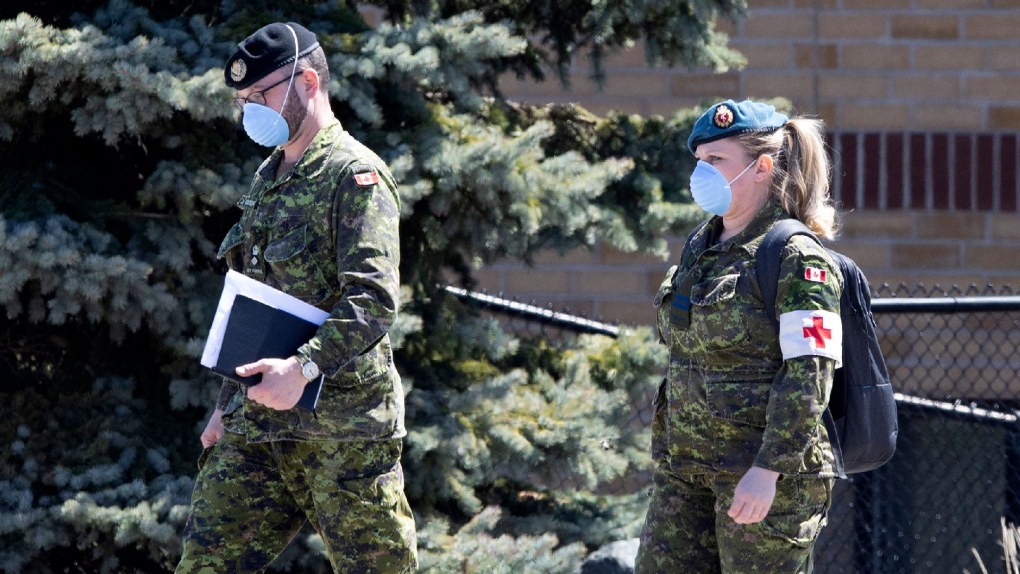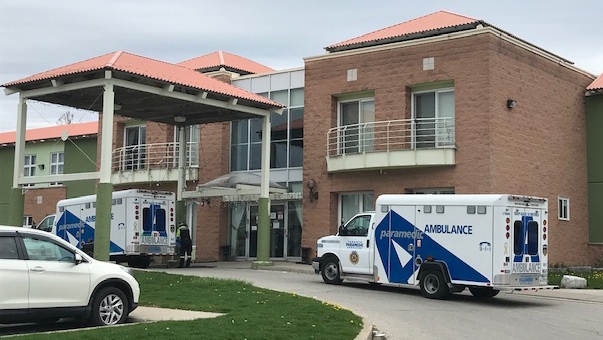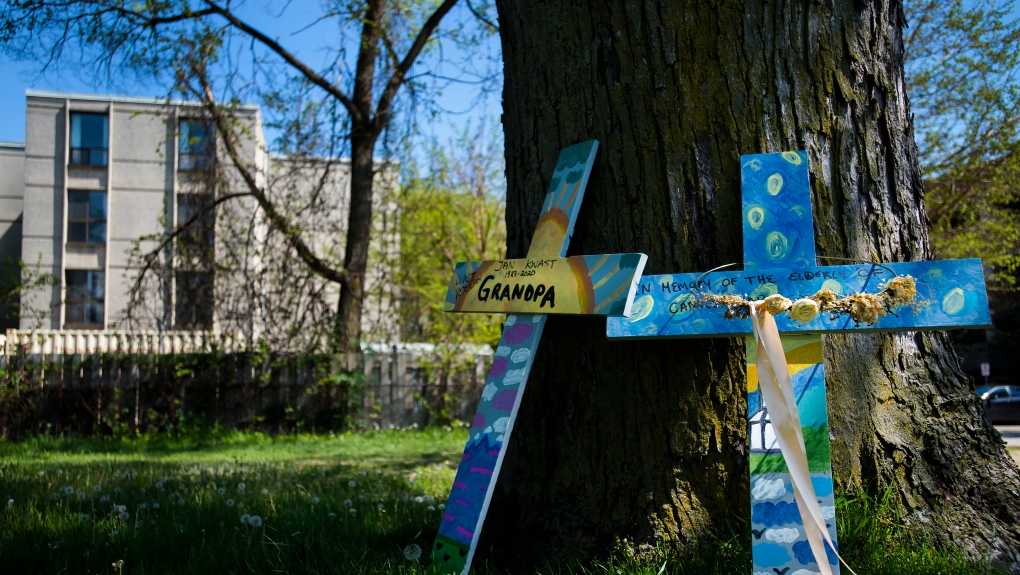Ontario company could get millions to rebuild nursing home where resident wasn't bathed for weeks before dying
The Doug Ford government says it has allocated hundreds of beds to the five Ontario long-term care chains at the centre of a military report that shocked the nation more than a year ago with details of horrifying conditions and neglect.
GEM Health Care Group Limited, which owns Downsview Long-Term Care Facility, a long-term care home where 65 people died due to COVID-19 is in the running to get public funds to build 21 new and 295 redeveloped beds — a move that critics say, “rewards” the companies running the homes where the greatest number of people died.
In a five-part series, CTV News Toronto is examining the province's decision to allocate potential new beds and funding to the five companies. Click the links to read part one on Southbridge Care Homes, part two on Sienna Senior Living and part three on Rykka Care Centres.
PART 4: GEM HEALTH CARE GROUP LIMITED
The Canadian Armed Forces entered Downsview Long-Term Care Facility in North York on June 2, 2020. By that time, 52 residents and one personal support worker had already died due to COVID-19 in the 252-bed facility.
Before arriving at Downsview, the military had already entered five other homes. The details of the alleged neglect and abuse they witnessed were released in a government report and a subsequent report released by the military on two long-term care homes, including Downsview.
The military report described severe issues of dehydration during the first wave at Downsview, saying, residents “died when all they need was water and a wipe down.” The military later clarified that it can’t definitively determine what caused residents to die, but significant concerns remained. Its report said there was “large concern” with the timing of their arrival at Downsview and that they should have been called in sooner. The military also reported there was a persistent cockroach infestation at the home.
A government inspection report also found issues at the home during the first wave. Inspectors said staff from Humber River Hospital were also sent to help at Downsview as the situation worsened. The hospital expressed concerns about the home’s cleanliness, the number of resident cases and deaths and the various infection, prevention and control issues.
A letter from the hospital to Downsview’s administrator listed a number of issues, including that residents were “observed dining in a congregate setting with limited social distancing,” and that “soiled linen” was stored next to “uncovered clean linen.” The letter went on to say that, “no one person initially identified from [the] management team” was responsible for leading outbreak management, there weren’t even enough garbage bins and that twice daily cleaning was scaled back due to staffing issues.
 A staff member escorts members of the Canadian Armed Forces in to a long-term care home, in Pickering, Ont. on Saturday, April 25, 2020. THE CANADIAN PRESS/Chris Young
A staff member escorts members of the Canadian Armed Forces in to a long-term care home, in Pickering, Ont. on Saturday, April 25, 2020. THE CANADIAN PRESS/Chris Young
The government inspection report went on to say that hospital staff “identified concerns related to nutrition and hydration in the home that posed a safety risk to residents.” A doctor from the hospital told inspectors that upon arrival they saw, “concerns related to nutrition and hydration, specifically that residents were not being fed appropriately, or receiving sufficient fluids.”
The report said the home admitted that the registered dieticians likely did not always receive referrals for residents at nutritional risk “because the home was critically short-staffed due to COVID-19.” Sixteen residents died during this time who experienced significant weight change and/or were at nutritional risk, but did not get checked by a registered dietician.
The government report also notes how the home failed to monitor and respond at times to a residents’ change in health, including in one instance when doctors were not notified about a resident in need of medical care. There were also incidents where a resident’s health would decline but family members would not be told about the change in condition. Inspectors said that the home failed to bathe residents properly. In one instance, inspectors referred to documents showing that a resident had not been bathed for weeks prior to her death.
The government report states that the GEM Health Care Group Limited CEO told inspectors that it was not aware of the issues happening inside its own long-term care home until it got a call from Humber River Hospital. The report said GEM Health Care Corporation failed to ensure the “home was a safe environment for the residents.”
RESIDENTS DIED IN 'HORRIFYING' NUMBERS
In the end, Downsview lost 65 residents throughout the pandemic due to COVID-19. And while Toronto was one of the hardest-hit cities in Ontario, other homes in the same area did not lose as many residents.
At Carefree Lodge’s 127-bed long-term care in North York, no one died throughout the pandemic and government inspectors never publically reported any problems with infection, prevention and control issues at the home. In addition, no residents died at the 136-bed Thompson House throughout the pandemic. Ontario inspection reports have not noted any infection, prevention and control issues at the home.
At the 174-bed Valleyview Residence, five people died, while at the 292-bed Cummer Lodge, and 202-bed Cheltenham Care Community, fewer than five people died. In North York, Downsview had an exceptionally high death rate, alongside Hawthorne Place, another home overseen by the military and owned by Rykka Care Centres.
In its most recent budget and campaign promise, the Ford government has promised to add 30,000 new long-term care beds over the next 10 years. It says another 20,161 new and 15,918 upgraded beds are in the “development pipeline.”
After GEM Health Care Group Limited applied for some of the beds, the government allocated it 22 new and 295 redeveloped beds. The company is proposing to use 252 of the 295 upgraded spaces for a reconstructed Downsview.
In an email to CTV News Toronto, the company’s CEO James Balcom said the 22 new beds would replace temporary beds currently at its Groves Park Lodge location in Renfrew, Ont.
 Downsview Long Term Care Centre is seen in this undated photo.
Downsview Long Term Care Centre is seen in this undated photo.
The family-owned for-profit company may receive millions of taxpayers’ dollars if their projects pass the consultation phase, a government process that critics call a “sham,” saying it does little to stop these companies from moving forward once allocations are granted. With Downsview’s license set to expire in 2025, a reconstructed facility could secure the home’s ability to operate beyond that date.
“GEM Health Care Group does appreciate the investment by the Government of Ontario for the replacement of existing beds, reflecting that much of the infrastructure we own in Ontario is of an age that requires modernization,” Balcom said.
“We have acted on any and all findings of the Ontario Ministry of Long-Term Care to improve the delivery of care for our residents. COVID-19 created a crisis without precedent for long-term care in Ontario.”
Natalie Mehra, the executive director of the Ontario Health Coalition, said she is aghast that GEM Health Care Group will get the chance to use the public’s money to redevelop a home where so many people lost their lives.
“What people went through in that home was horrific,” she told CTV News Toronto on Thursday. “I mean people went without the hydration and the feeding that they needed. The staffing collapsed and residents died in really shocking numbers, horrifying numbers.”
“The idea that the government would consider a rebuild paid for by public money to help such an operator is staggering. The ministry is required under the law to consider the record of the long-term operator. What would one have to do to not get allocations in Ontario if they are giving them to a place like Downsview?”
CHRONIC ISSUES EVEN BEFORE PANDEMIC, CRITICS SAY
Long-Term Care Minister Rod Phillips did not provide an answer to CTV News Toronto when asked why the long-term care homes listed in the military report have not been penalized, and are instead getting allocations for new beds.
NDP MPP Tom Rakocevic told CTV News Toronto that he still hears concerns about Downsview from residents in his riding. He said he spoke to a woman named Myrelyn Daley, who lost her sister at Downsview.
“The issue that Myrelyn’s sister was facing were happening much before the pandemic; issues of her not being hydrated, asking for food and not being fed, in many cases not changed properly. So many issues predated the pandemic,” Rakocevic said. “Myrelyn said how someone her sister had lunch with at a table had COVID and eventually that spread.”
Rakocevic said he was told that Daley's sister, who had mobility issues, would sometimes, “call her on the phone, crying until she almost passed out.” She died on April 24 after she was rushed to hospital.
Rakocevic said he believes the current government is rewarding bad actors by providing GEM Health Care Group with allocations to get new and redeveloped beds.
“For-profit operations that have really failed their residents, and ultimately lives were lost, are turning around and being awarded to go forward,” he said. “The future of long term care, if we really want to care about those living there, has to be through public and non-profit delivery and not through for-profits.”
“Rather than ensuring people are being taken care of in these places, the for-profit operators are just trying to expand their profit margins and governments are going around and giving them a pat on the back to move forward,” he said.
“It’s very disappointing to see in cases where there have been neglect in long-term care at homes like that.”
 Crosses are displayed outside a long-term care centre marking the deaths of multiple people that occurred during the COVID-19 pandemic. THE CANADIAN PRESS/Nathan Denette
Crosses are displayed outside a long-term care centre marking the deaths of multiple people that occurred during the COVID-19 pandemic. THE CANADIAN PRESS/Nathan Denette
According to data collected by the Ontario Health Coalition, the COVID-19 death rate during the pandemic involving for-profit long-term care homes in the province is about nine per cent. Comparatively, in not-for-profit homes it stood at 5.25 per cent and, in publicly-owned homes, the number dropped to 3.62 per cent.
The Minister of Long-Term Care Rod Phillips revealed earlier this week that 140 of 220 new homes – or more than 60 per cent of the government’s pipeline – are currently being awarded to for-profit homes.
Currently, 58 per cent of long-term care homes in Ontario already belong to for-profit companies, a number unseen anywhere else in Canada. The province’s latest round of applications for long-term care bed allocations closes on Nov. 2, 2021. The applications are open to all for-profit, not-for-profit and municipal operators.
“Why would we be paying for-profit companies especially those with hideous records to be building the next generation of long-term care homes? It’s absurd,” Mehra said. “More than 4,000 people are dead and that's not in keeping with the rest of the world, like no one else saw death rates like we saw in Canada in long-term care homes.”
A spokesperson for the Ontario Ministry of Long-Term Care told CTV News Toronto that the COVID-19 pandemic revealed the need to update and modernize long-term care homes, which means that even for-profit homes will get public funding to fix the issues in their facilities and build new beds.
The ministry also told CTV News Toronto that the pandemic showcased the need to update homes in order to prevent the spread of outbreaks. A spokesperson said the province will add capacity to areas of Ontario with “significant demand.”
FORGOTTEN: Part five will be released tomorrow on CTVNewsToronto.ca
CTVNews.ca Top Stories

BREAKING Israel attacks Iran, Reuters sources say; drones reported over Isfahan
Israel has attacked Iran, three people familiar with the matter told Reuters, as Iranian state media reported early on Friday that its forces had destroyed drones, days after Iran launched a retaliatory drone strike on Israel.
American millionaire Jonathan Lehrer denied bail after being charged with killing Canadian couple
American millionaire Jonathan Lehrer, one of two men charged in the killings of a Canadian couple in Dominica, has been denied bail.
Nearly half of China's major cities are sinking, researchers say
Nearly half of China's major cities are suffering 'moderate to severe' levels of subsidence, putting millions at risk of flooding especially as sea levels rise.
Prince Harry formally confirms he is now a U.S. resident
Prince Harry, the son of King Charles III and fifth in line to the British throne, has formally confirmed he is now a U.S. resident.
Judge says 'no evidence fully supports' murder case against Umar Zameer as jury starts deliberations
The judge presiding over the trial of a man accused of fatally running over a Toronto police officer is telling jurors the possible verdicts they may reach based on the evidence in the case.
Health Canada to change sperm donor screening rules for men who have sex with men
Health Canada will change its longstanding policy restricting gay and bisexual men from donating to sperm banks in Canada, CTV News has learned. The federal health agency has adopted a revised directive removing the ban on gay, bisexual and other men who have sex with men, effective May 8.
Colin Jost names one celebrity who is great at hosting 'Saturday Night Live'
Colin Jost, who co-anchors Saturday Night Live's 'Weekend Update,' revealed who he thinks is one of the best hosts on the show.
Sports columnist apologizes for 'oafish' comments directed at Caitlin Clark. The controversy isn't over
A male columnist has apologized for a cringeworthy moment during former University of Iowa superstar and college basketball's highest scorer Caitlin Clark's first news conference as an Indiana Fever player.
'Shopaholic' author Sophie Kinsella reveals brain cancer diagnosis
Sophie Kinsella, the best-selling author behind the 'Shopaholic' book series, has revealed that she is receiving treatment for brain cancer.
































